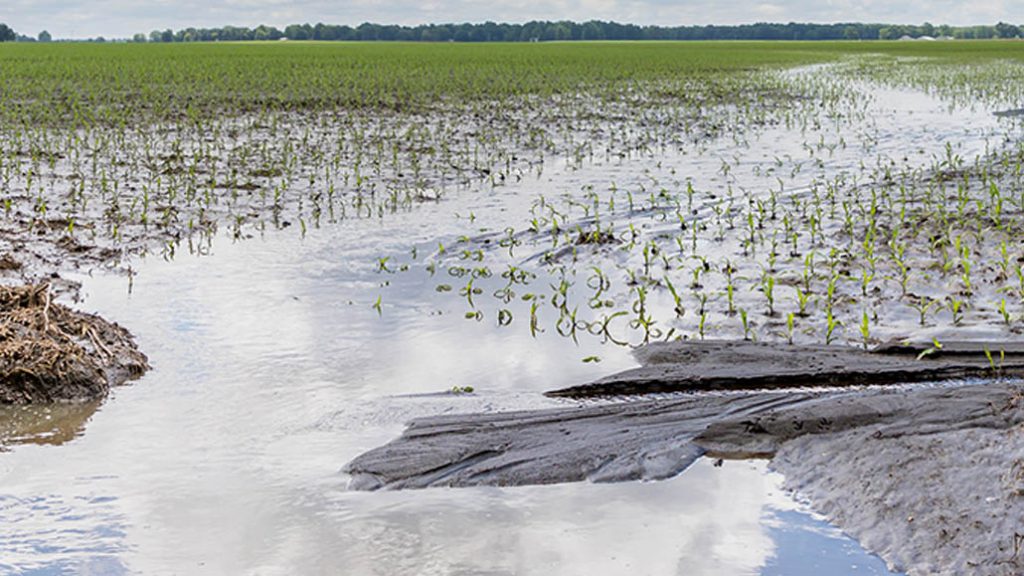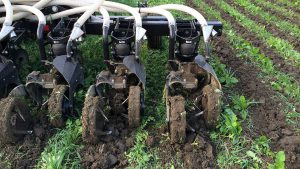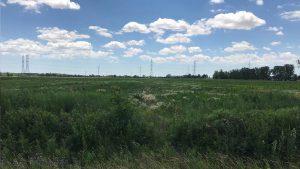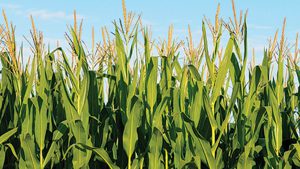Flooded fields
RAIN DEVASTATES U.S. CORN BELT

AS 2019 TURNED to spring, U.S. farmers were poised to plant 92.8 million acres of corn, 84.6 million acres of soybeans, and 45.8 million acres of wheat, according to the U.S. Department of Agriculture’s March 29 Projected Plantings report. That would have been a four per cent increase in corn acres and a five per cent decline in soybean acres.
Then the rains and the flooding hit.
The Missouri River basin recorded more runoff in March, April, and May than it normally gets in a year. At least 30 levees failed. A number of communities were completely flooded and cut off as roads were washed out. Interstate 29, which was under as much as 15 feet of water, was closed from Council Bluffs to St. Joseph, Missouri. Much of that area is still under water and is projected to remain flooded through the summer.
The damage to farms reaches well beyond the nightly news images. The nine Iowa counties alone that border the Missouri River accounted for more than 2.5 million acres of corn and soybeans last year. Much of that land will not produce a crop this year. Estimates of how much acreage will be lost across the whole region run as high as 10 million.
Once the water does subside, farmers face the long-term challenges of clearing flood-born debris, restoring fields ravaged by the flood waters, and re-building millions of dollars worth of farm buildings and infrastructure. That will include an estimated 832 on-farm storage bins damaged by flood waters. Typical steel bins are not designed to resist flood waters, concrete foundations have been undercut or washed away, electrical systems have been destroyed, and bin walls have ruptured as soaked grain expanded.
According to U.S. Agriculture Under Secretary Bill Northey, “there’s nothing the U.S. government can do about the millions of bushels of damaged crops here under current laws or disaster-aid programs,” unless Congress passes new legislation to aid farmers who lost stored grain.
Grain that has been submerged in floodwater is considered to be adulterated and must be destroyed.
Weather-related challenges aren’t limited to the Missouri flood plain. The weather pattern has been waves of rainy days alternating with single dry days. The result has been additional flooding on the Mississippi River and its tributaries and saturated soils that prevented field work in both the eastern and western corn belt.
By June 2, when corn planting is wrapping up in most years and soybean seeding is well advanced, field work was three weeks behind schedule in the corn belt — only 80% complete in Iowa, 45% in Illinois, 88% in Nebraska, 76% in Minnesota, and 31% in Indiana.
For corn farmers, that created a difficult decision: try to complete corn planting, despite the yield declines that can begin to affect production for corn planted after mid-May, or shift to soybeans, even though they may be less profitable than corn under current market conditions.
An added concern was whether extreme precipitation has affected the levels of nitrogen remaining in the soil.
Farmers have a third alternative. They can take a “prevented planting” payment and save the input costs on unplanted acres; but prevented planting payments are less than what crops would typically earn in the marketplace.
A further complication with this option is that payments under the Trump Administration’s trade assistance for farmers are expected to be calculated based on production, leaving out farmers who take the prevented planting route.
All this adds up to a lot of uncertainty about the final acreage numbers and the potential 2019 corn crop in particular. The USDA’s World Agricultural Supply and Demand Estimates (WASDE) for June has already reduced its corn production estimate by 1.4 billion bushels to 13.7 billion bushels (the lowest figure since 2015/16) and dropped its corn yield number to 166 bushels per acre.
For a recap of Ontario’s spring planting challenges, read the field conditions reports (spring) (summer) from Marty Vermey, senior agronomist at Grain Farmers of Ontario. •






















